Comet Catalina (C/2013 US10) is running about a magnitude fainter than predicted now that it's emerging into view low in the east at dawn. So it's on track to glow at 6th magnitude, not 5th, as it climbs high into the predawn eastern sky through December and January. See the December Sky & Telescope, page 45, or Get a Predawn Peek of Comet Catalina.
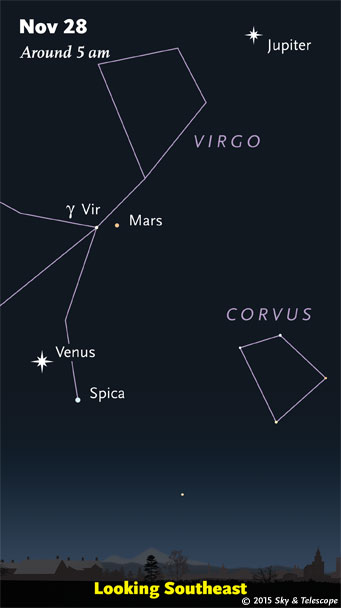
Friday, November 27
• Before and during dawn, Venus shines within 5° of Spica from tomorrow through December 2nd. Tomorrow morning, look also for 2nd-magnitude Gamma Virginis (Porrima) just to Mars's left, as shown here.
Saturday, November 28
• By 8 or 9 p.m. the waning gibbous Moon is up in the east-northeast. It's in Gemini; look left of it and perhaps a bit higher for Castor and Pollux. Farther to the Moon's right or upper right, Orion is moving up.
Sunday, November 29
• By 10 or 11 p.m. now (depending in how far east or west you live in your time zone), the dim Little Dipper hangs straight down from Polaris.
Monday, November 30
• Two faint fuzzies naked-eye: The Andromeda Galaxy (M31) and the Perseus Double Cluster are two of the most famous deep-sky objects. They're both cataloged as 4th magnitude, and in a fairly good sky you can see each with the unaided eye. They're located only 22° apart, high in the northeast these evenings — to the right of Cassiopeia and closer below Cassiopeia, respectively.
But they look rather different, the more so the darker your sky. See for yourself. They're plotted on the all-sky constellation map in the center of the November Sky & Telescope.
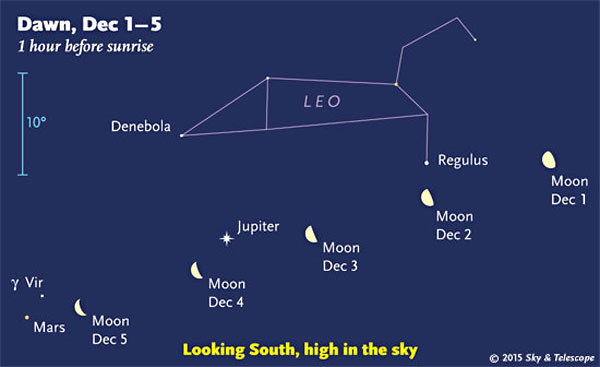
Tuesday, December 1
• This evening is dark and moonless until the waning Moon rises around 11 p.m. Once the Moon is up, look for Regulus about 4° left of it (for North America). By dawn on the 2nd the Moon is under Regulus, as shown above.
Wednesday, December 2
• The last-quarter Moon rises in the east around 11 or midnight tonight. You'll find it hanging below Regulus. About 50 minutes later, Jupiter rises below the Moon. By dawn on Thursday the 3rd, the three of them stand high in the south — while Venus blazes in the southeast.
Thursday, December 3
• Jupiter and the Moon shine together after rising after midnight tonight. In early dawn on Friday the 4th, they stand paired less closely (for North America) high in the south, as shown above. By then Mars, Spica, and bright Venus shine to their lower left.
Friday, December 4
• The big Summer Triangle is still laid out the western sky after dark these cold evenings. Its brightest star is Vega, the brightest in the area. Look above Vega for Deneb. Farther to Vega's left or lower left is Altair.
• Before and during dawn on Saturday the 5th, bright Venus in the southeast anchors a diagonal line that stretches upper right past Spica to connect Mars, the waning Moon, and then Jupiter.
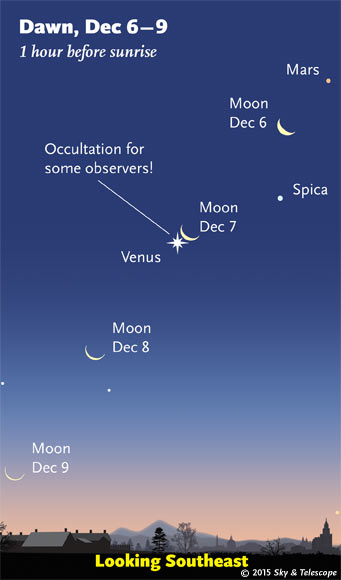
Saturday, December 5
• In early dawn on Sunday morning the 6th, the waning crescent Moon hangs roughly between Mars and Spica, as shown at right.
• Advance notice: during daytime on Monday, the Moon will occult (cover) Venus for practically everyone with a telescope or binoculars in the U.S., Mexico, and Central America. See the December Sky & Telescope, page 46.
__________________________
Want to become a better astronomer? Learn your way around the constellations. They're the key to locating everything fainter and deeper to hunt with binoculars or a telescope.
This is an outdoor nature hobby. For an easy-to-use constellation guide covering the whole evening sky, use the big monthly map in the center of each issue of Sky & Telescope, the essential guide to astronomy.
Once you get a telescope, to put it to good use you'll need a detailed, large-scale sky atlas (set of charts). The basic standard is the Pocket Sky Atlas (in either the original or new jumbo edition), which shows stars to magnitude 7.6. Next up is the larger and deeper Sky Atlas 2000.0 (stars to magnitude 8.5), and once you know your way around, the even larger Uranometria 2000.0 (stars to magnitude 9.75). And read how to use sky charts with a telescope.
You'll also want a good deep-sky guidebook, such as Sue French's Deep-Sky Wonders collection (which includes its own charts), Sky Atlas 2000.0 Companion by Strong and Sinnott, or the bigger Night Sky Observer's Guide by Kepple and Sanner.
Can a computerized telescope replace charts? Not for beginners, I don't think, and not on mounts and tripods that are less than top-quality mechanically (meaning heavy and expensive). As Terence Dickinson and Alan Dyer say in their Backyard Astronomer's Guide, "A full appreciation of the universe cannot come without developing the skills to find things in the sky and understanding how the sky works. This knowledge comes only by spending time under the stars with star maps in hand."
This Week's Planet Roundup
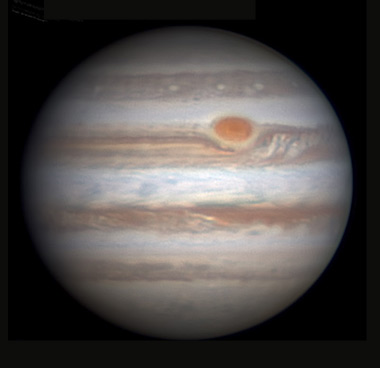
Mercury is buried in the glow of sunset, on its way to a fine apparition later in December.
Venus, Mars, and Jupiter continue their display in the east before and during dawn. Venus is the lowest and brightest, shining at magnitude –4.2. Jupiter, high to the upper right, is –2.0, and Mars, between them, is much fainter at +1.5.
Watch the line lengthening. Venus is descending; Jupiter and Mars are moving higher. So is Spica; watch it pass to the right of Venus this week.
Saturn is hidden in conjunction with the Sun.
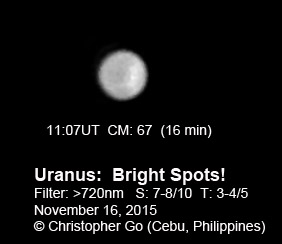
Uranus (magnitude +5.7, in Pisces) and Neptune (magnitude +7.9, in Aquarius) are high in the southern sky during early evening. Finder charts for Uranus and Neptune.
__________________________
All descriptions that relate to your horizon — including the words up, down, right, and left — are written for the world's mid-northern latitudes. Descriptions that also depend on longitude (mainly Moon positions) are for North America.
Eastern Standard Time (EST) is Universal Time (UT, UTC, or GMT) minus 5 hours.
__________________________
"We may be little guys, but we don’t think small. It’s the courage of questions, of grasping our true circumstances, and not pretending we are at the center of it all, that is adulthood."
— Ann Druyan, 2014
 0
0
Comments
You must be logged in to post a comment.